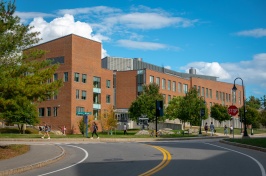Rural Workers More Likely to Work at Middle-Skill Jobs

DURHAM, N.H. - Rural workers are more likely to work at middle-skill jobs that do not require a four-year college degree compared with their urban counterparts, according to new research from the Carsey Institute at the University of New Hampshire.
The new research is presented in the Carsey Institute policy brief "Middle-Skill Jobs Remain More Common Among Rural Workers." The research was conducted by Justin Young, a doctoral student in sociology at UNH and a research assistant at the Carsey Institute.
Middle-skill jobs are defined as positions requiring at least some on-the-job training, an apprenticeship-type experience, or postsecondary education but no more than a two-year degree. They represent occupations that have been crucial to the American economy since the 1950s, including blue-collar positions such as those in the manufacturing and construction industries.
"Two different trends are apparent in rural versus urban America. In rural places, the prevalence of middle-skill work has remained relatively stable over the last decade. In urban areas, however, these jobs have slowly but steadily declined in number," Young said. "As policy makers continue to press for initiatives to put more Americans back to work, they must recognize the role that middle-skill jobs play in the U.S. economy."
Young found:
- Roughly half (51 percent) of American workers living in rural areas held middle-skill jobs in 2012. This figure is well above the national average of 43 percent and the urban average of 42 percent.
- Since 2003, the percentage of workers holding middle-skill jobs has not changed in rural places but has declined slightly in urban areas, reflecting a long-term downward trajectory in these types of occupations. National declines in recent years in the availability of middle-skill work thus appear to reflect an urban rather than rural trend.
- Despite this trend, some middle-skill occupations are growing. Much of this growth is driven by the increasingly important role that the service sector - in particular, the health care field - plays in the U.S. economy.
- Half of all working men, but only 35 percent of working women, hold middle-skill jobs. In urban places, white, Hispanic, and black workers were equally likely to hold middle-skill jobs, but in rural areas Hispanics were substantially more likely to hold middle-skill jobs than white or black workers. Older workers are more likely than younger workers to hold middle-skill jobs.
"Although the middle-skill sector continues to represent an avenue to well-paying occupations that do not require formal education beyond a high school level, an increasing number of these jobs, such as those in the health care field, require workers to obtain a two-year degree or some other credential," Young said.
"Some rural counties rich in natural amenities that are attracting older Americans are likely to experience a change in the demand for registered nurses, medical assistants, and other middle-skill workers who play a critical role in the health sector. Job-training programs should consider the growing role that these jobs will play in the future of the U.S. economy," he said.
This research relies on data from the Annual Social and Economic Supplement to the Current Population Survey, provided by the Integrated Public Use Microdata Series.
The complete Carsey Institute report about this research is available at http://www.carseyinstitute.unh.edu/publication/761.
The Carsey Institute conducts policy research on vulnerable children, youth, and families and on sustainable community development. The institute gives policy makers and practitioners the timely, independent resources they need to effect change in their communities. For more information about the Carsey Institute, go to www.carseyinstitute.unh.edu.
The University of New Hampshire, founded in 1866, is a world-class public research university with the feel of a New England liberal arts college. A land, sea, and space-grant university, UNH is the state's flagship public institution, enrolling 12,200 undergraduate and 2,300 graduate students.
GRAPHICS
/unhtoday/news/releases/2013/jun/carsey.jpg
Percentage of workers employed in low-, middle-, and high-skill jobs by place, 2003-2012.
-30-
Latest News
-
October 24, 2025
-
October 8, 2025
-
October 2, 2025
-
September 24, 2025
-
September 15, 2025















































